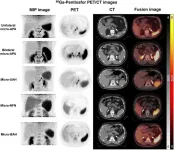(Press-News.org) Living in a high-income neighborhood, having private health insurance, and being older are tied to an increased likelihood that life support will be withdrawn for people who have suffered severe bleeding in the brain, a new study shows.
Led by researchers at NYU Grossman School of Medicine, the study focused on the social and economic factors linked to the withdrawal of life support and related death after being hospitalized for intracerebral hemorrhages. Such bleeds, sometimes referred to as hemorrhagic stroke, often lead to swelling in the brain, which can put a patient into a coma and frequently cause death.
Previous studies had identified racial and religious disparities in death rates after such hemorrhages, with higher rates seen among Black and Hispanic patients and patients with deeply held religious beliefs.
The study authors say their new work, published in the journal Neurology online Jan. 18, is important because it offers a better understanding of disparities that may help physicians to tailor end-of-life conversations with patients’ families, with the goal of removing age, racial, and economic disparities in health care.
Unlike ischemic stroke, which is caused by blocked blood vessels that can be cleared in many cases, hemorrhagic strokes are more often deadly. Some hemorrhagic stroke patients may undergo surgery to minimize the effects of swelling. In most cases, however, recovery is limited, and many patients need life-sustaining assistance with breathing and feeding. For these reasons, many patients and their families choose to withdraw life support.
For the new study, researchers examined the medical records of 868 patients admitted to three NYU Langone Health hospitals in Manhattan, Brooklyn, and Long Island for intracerebral hemorrhage from 2017 through 2022. Most were seniors and men of all races, with half relying on Medicare and one in five on Medicaid. While many survived their severe brain bleed and were discharged home or to a rehabilitation or nursing facility, 148 did not, and most of the decedents (84%) had had their life support, including ventilators and feeding tubes, withdrawn during their hospital stay.
The researchers found that hemorrhagic stroke patients living in city neighborhoods with higher incomes (i.e., above a yearly median of $88,687) were as much as 88% more likely to have life support withdrawn and to die subsequently than those living in poorer parts of the city (i.e., with yearly median incomes below $70,784). Being older than age 77 and on Medicare also heightened chances of having life support ended.
By contrast, being Black and having private insurance were factors tied to a lower likelihood of life support being withdrawn. Among hospitalized hemorrhagic stroke patients, Blacks made up 7% of those who had life support withdrawn but counted for 18% of those who maintained life support. Similarly, while 37% had private health insurance, only 20% of those who decided to withdraw life support had private insurance.
Among the other study findings, Christians, especially Catholics, were 10% more likely to have life support withdrawn poststroke than maintained, and Jewish patients were 15% more likely to have life support maintained than withdrawn.
“Our study results highlight the many complex social, economic, religious, and racial factors that may play a role in decision making after a patient has suffered a severe bleed in the brain, or hemorrhagic stroke, and dies after withdrawal of life support,” said study lead investigator and neurologist Kara Melmed, MD.
Melmed, a clinical assistant professor in the Departments of Neurology and Neurosurgery at NYU Langone, says that while it has long been known that socioeconomic factors play a role in health and how well people recover, the role of these factors, beyond religion and race, have not until now been explored in detail for patients with intracerebral hemorrhages.
Further research is needed, the researchers say, because death is far more common in hemorrhagic stroke than in ischemic stroke.
Strokes of all kinds in the United States are not only a leading cause of death, but are also a health care disparity concern because strokes are twice as common in Blacks than in non-Blacks.
“Knowing that socioeconomic factors, especially income, play a role in hemorrhagic stroke outcomes is the first step in comprehending why these imbalances exist and how best to address them to make health care more equitable,” said senior study investigator and neurologist Jennifer Frontera, MD.
“Seeing any kind of disparity in health care is concerning,” said Frontera, a professor in the Department of Neurology at NYU Langone. “Clinicians in future may need to tailor end-of-life care discussions, taking into account cultural and social factors when treating patients who have suffered an intracerebral hemorrhage and, in particular, with respect to withdrawing life support.”
Besides Melmed and Frontera, other researchers at NYU Langone involved in this study, which was self-funded by the health system, are Ariane Lewis, MD; Lindsey Kuohn, MD; Joanna Marmo, BSN, RN, SCRN; Nirmala Rossan-Raghunath, MSN, SCRN; Jose Torres, MD; Rajanandini Muralidharan, MD; Aaron Lord, MD; and Koto Ishida, MD.
Media Inquiries:
David March
212-404-3528
david.march@nyulangone.org
END
Household income and health insurance among factors in decision to withdraw life support after hemorrhagic stroke
2024-01-18
ELSE PRESS RELEASES FROM THIS DATE:
Xue lab at the CDI publishes groundbreaking insights into memory T cells in Nature Immunology
2024-01-18
The Xue Lab at the Hackensack Meridian Center for Discovery and Innovation (CDI) has made another breakthrough in better understanding, and potentially modulating, the immune system to fight diseases.
The insights into a specific protein and how it regulates the training and efficacy of central memory T cells are published by Hai-Hui (Howard) Xue, a member of the CDI, in the journal Nature Immunology.
The immunological implications could produce better vaccines and cancer treatments in the future, according to the Xue lab, which is also part of the Institute for Immunologic ...
Don’t look back: The aftermath of a distressing event is more memorable than the lead-up, study suggests
2024-01-18
Halfway through a true crime podcast, a morning commuter jerks the wheel to narrowly avoid a collision. When discussing the podcast with a coworker later that day, the driver can easily recall the details of the episode’s second half but retains only a blurry recollection of how it began.
A new study from psychologists at the Beckman Institute for Advanced Science and Technology suggests that we remember the moments immediately following a distressing episode more sharply than the moments leading up to it. Clarifying the relationship ...
FIFA World Cup ends with win for Argentina and COVID-19, new research finds
2024-01-18
TORONTO, Jan. 18, 2024 – The 2022 FIFA World Cup ended with a tight win for Argentina over France on penalties, but it was also a triumph for SARS-CoV-2 with a significant jump in the number of cases, some of which York University researchers say could have been prevented.
New research published today and led by York used the 2022 FIFA World Cup as a case study to help determine the best ways to mitigate virus spread and hospitalizations at mass gatherings in the future. A technique was used ...
New PET/CT technique accurately diagnoses adrenal gland disorder, informs personalized treatment plans
2024-01-18
Reston, VA—A novel imaging approach, 68Ga-pentixafor PET/CT, has been shown to accurately identify sub-types of primary aldosteronism (an adrenal gland disorder), outperforming traditional methods for diagnosis. Reported in the January issue of The Journal of Nuclear Medicine, this detailed imaging technique provides a clearer picture of the adrenal glands, helping doctors decide more confidently whether surgery is the right option for patients.
Primary aldosteronism is an endocrine disorder that occurs when the adrenal glands produce too much of the hormone aldosterone, frequently ...
A window into plant evolution: The unusual genetic journey of lycophytes
2024-01-18
An international team of researchers has uncovered a remarkable genetic phenomenon in lycophytes, which are similar to ferns and among the oldest land plants. Their study, recently published in the journal PNAS, reveals that these plants have maintained a consistent genetic structure for over 350 million years, a significant deviation from the norm in plant genetics.
"The exceptionally slow pace of genomic evolution sets these plants apart," said Dr. Fay-Wei Li, a professor at the Boyce Thompson Institute and a senior author of the study. ...
Climate change linked to spread of diarrheal illness
2024-01-18
Temperature, day length and humidity have been found to be linked to the increased spread of a diarrhoeal illness a new study from the University of Surrey reveals. The findings could help predict further outbreaks of the illness, potentially leading to better preparedness within health services.
During this unique study, researchers led by Dr Giovanni Lo Iacono, investigated the impact of weather on the transmission of campylobacteriosis, a bacterial infection which can cause diarrhoea and stomach pains. According to the World Health Organisation, Campylobacter infections are the most common causes of human bacterial gastroenteritis in the world. Infections are generally ...
Injectable agents could improve liquid biopsy for cancer detection and monitoring
2024-01-18
Scientists have developed two agents, made of therapeutic nanoparticles and antibodies, that could be given to patients shortly before a blood draw to allow physicians to better detect tumor DNA in blood using a technology called liquid biopsy.
Liquid biopsies promise to transform how cancers are diagnosed, monitored, and treated by detecting DNA that tumors shed into the blood. But the body presents a significant challenge. Immune cells in the liver and DNA-degrading enzymes in blood remove circulating tumor DNA from the bloodstream within minutes, making this DNA difficult to capture and detect in a blood test.
To overcome this, a team from the Broad Institute of MIT and Harvard ...
A fungal pathogen, Rosellinia necatrix, that attacks plants, produces antimicrobials to combat the plant-hosted bacteria that would otherwise inhibit its infection success
2024-01-18
A fungal pathogen, Rosellinia necatrix, that attacks plants, produces antimicrobials to combat the plant-hosted bacteria that would otherwise inhibit its infection success.
####
Article Title: The soil-borne white root rot pathogen Rosellinia necatrix expresses antimicrobial proteins during host colonization
Article URL: http://journals.plos.org/plospathogens/article?id=10.1371/journal.ppat.1011866
Author Countries: Germany, Spain, the Netherlands
Funding: EACC and DET acknowledge receipt of PhD fellowships from CONACyT, Mexico. ALM is holder of a postdoctoral research fellow funded by the 'Fundación Ramón Areces'. BPHJT ...
Researchers improve blood tests’ ability to detect and monitor cancer
2024-01-18
CAMBRIDGE, MA -- Tumors constantly shed DNA from dying cells, which briefly circulates in the patient’s bloodstream before it is quickly broken down. Many companies have created blood tests that can pick out this tumor DNA, potentially helping doctors diagnose or monitor cancer or choose a treatment.
The amount of tumor DNA circulating at any given time, however, is extremely small, so it has been challenging to develop tests sensitive enough to pick up that tiny signal. A team of researchers from MIT and the Broad Institute of MIT and Harvard has now come up with a way to significantly boost that signal, by temporarily slowing the clearance of tumor DNA circulating in the bloodstream.
The ...
Sea otters may be key drivers of changes in California's kelp forests, according to data spanning a century
2024-01-18
Sea otters may be key drivers of changes in California's kelp forests, according to data spanning a century
#####
In your coverage please use this URL to provide access to the freely available article in PLOS Climate: https://journals.plos.org/climate/article?id=10.1371/journal.pclm.0000290
Article Title: Sea otter recovery buffers century-scale declines in California kelp forests
Citation: Nicholson TE, McClenachan L, Tanaka KR, Van Houtan KS (2024) Sea otter recovery buffers century-scale declines in California ...





